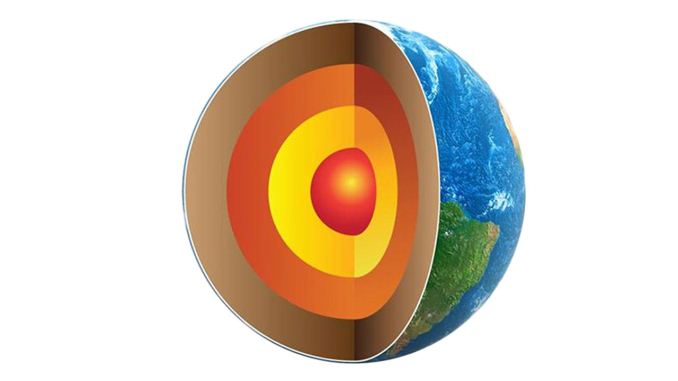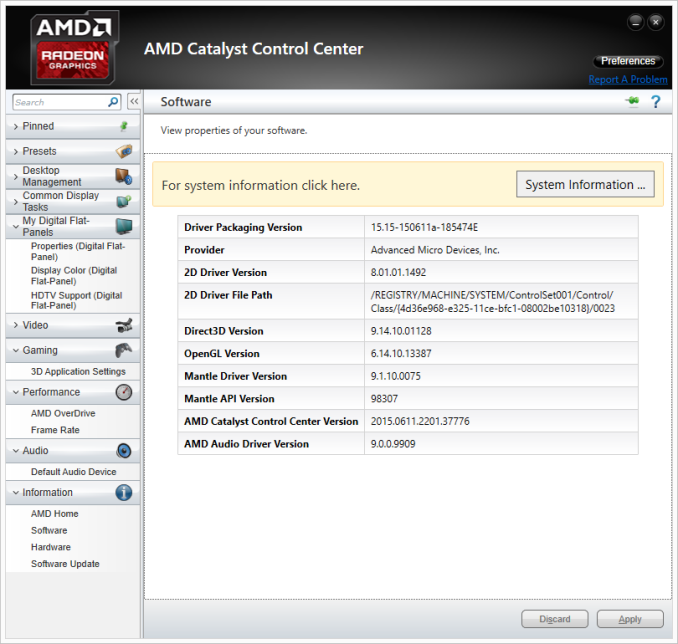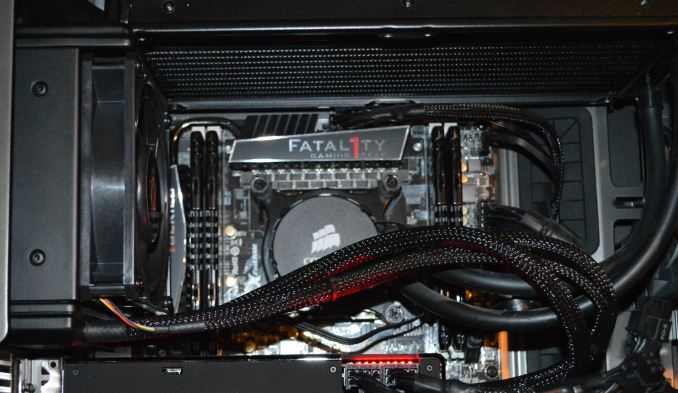The AMD Radeon R9 Fury X Review: Aiming For the Top
by Ryan Smith on July 2, 2015 11:15 AM ESTThe State of Mantle, The Drivers, & The Test
Before diving into our long-awaited benchmark results, I wanted to quickly touch upon the state of Mantle now that AMD has given us a bit more insight into what’s going on.
With the Vulkan project having inherited and extended Mantle, Mantle’s external development is at an end for AMD. AMD has already told us in the past that they are essentially taking it back inside, and will be using it as a platform for testing future API developments. Externally then AMD has now thrown all of their weight behind Vulkan and DirectX 12, telling developers that future games should use those APIs and not Mantle.
In the meantime there is the question of what happens to existing Mantle games. So far there are about half a dozen games that support the API, and for these games Mantle is the only low-level API available to them. Should Mantle disappear, then these games would no longer be able to render at such a low-level.
The situation then is that in discussing the performance results of the R9 Fury X with Mantle, AMD has confirmed that while they are not outright dropping Mantle support, they have ceased all further Mantle optimization. Of particular note, the Mantle driver has not been optimized at all for GCN 1.2, which includes not just R9 Fury X, but R9 285, R9 380, and the Carrizo APU as well. Mantle titles will probably still work on these products – and for the record we can’t get Civilization: Beyond Earth to play nicely with the R9 285 via Mantle – but performance is another matter. Mantle is essentially deprecated at this point, and while AMD isn’t going out of their way to break backwards compatibility they aren’t going to put resources into helping it either. The experiment that is Mantle has come to an end.
This will in turn impact our testing somewhat. For our 2015 benchmark suite we began using low-level APIs when available, which in the current game suite includes Battlefield 4, Dragon Age: Inquisition, and Civilization: Beyond Earth, not counting on AMD to cease optimizing Mantle quite so soon. As a result we’re in the uncomfortable position of having to backtrack on our policies some in order to not base our recommendations on stupid settings.
Starting with this review we’re going to use low-level APIs when available, and when using them makes performance sense. That means we’re not going to use Mantle in the cases where performance has clearly regressed due to a lack of optimizations, but will use it for games where it still works as expected (which essentially comes down to Civ: BE). Ultimately everything will move to Vulkan and DirectX 12, but in the meantime we will need to be more selective about where we use Mantle.
The Drivers
For the launch of the 300/Fury series, AMD has taken an unexpected direction with their drivers. The launch driver for these parts is the Catalyst 15.15 driver, AMD’s next major driver branch which includes everything from Fiji support to WDDM 2.0 support. However in launching these parts, AMD has bifurcated their drivers; the new cards get Catalyst 15.15, the old cards get Catalyst 15.6 (driver version 14.502).
Eventually AMD will bring these cards back together in a later driver release, after they have done more extensive QA against their older cards. In the meantime it’s possible to use a modified version of Catalyst 15.15 to enable support for some of these older cards, but unsigned drivers and Windows do not get along well, and it introduces other potential issues. Otherwise considering that these new drivers do include performance improvements for existing cards, we are not especially happy with the current situation. Existing Radeon owners are essentially having performance held back from them, if only temporarily. Small tomes could be written on AMD’s driver situation – they clearly don’t have the resources to do everything they’d like to at once – but this is perhaps the most difficult situation they’ve put Radeon owners in yet.
The Test
Finally, let’s talk testing. For our benchmarking we have used AMD’s Catalyst 15.15 beta drivers for the R9 Fury X, and their Catalyst 15.5 beta drivers for all other AMD cards. Meanwhile for NVIDIA cards we are on release 352.90.
From a build standpoint we’d like to remind everyone that installing a GPU radiator in our closed cased test bed does require reconfiguring the test bed slightly; a 120mm rear exhaust fan must be removed to make room for the GPU radiator.
| CPU: | Intel Core i7-4960X @ 4.2GHz |
| Motherboard: | ASRock Fatal1ty X79 Professional |
| Power Supply: | Corsair AX1200i |
| Hard Disk: | Samsung SSD 840 EVO (750GB) |
| Memory: | G.Skill RipjawZ DDR3-1866 4 x 8GB (9-10-9-26) |
| Case: | NZXT Phantom 630 Windowed Edition |
| Monitor: | Asus PQ321 |
| Video Cards: | AMD Radeon R9 Fury X AMD Radeon R9 295X2 AMD Radeon R9 290X AMD Radeon R9 285 AMD Radeon HD 7970 NVIDIA GeForce GTX Titan X NVIDIA GeForce GTX 980 Ti NVIDIA GeForce GTX 980 NVIDIA GeForce GTX 780 Ti NVIDIA GeForce GTX 680 NVIDIA GeForce GTX 580 |
| Video Drivers: | NVIDIA Release 352.90 Beta AMD Catalyst Cat 15.5 Beta (All Other AMD Cards) AMD Catalyst Cat 15.15 Beta (R9 Fury X) |
| OS: | Windows 8.1 Pro |













458 Comments
View All Comments
testbug00 - Sunday, July 5, 2015 - link
You don't need architecture improvements to use DX12/Vulkan/etc. The APIs merely allow you to implement them over DX11 if you choose to. You can write a DX12 game without optimizing for any GPUs (although, not doing so for GCN given consoles are GCN would be a tad silly).If developers are aiming to put low level stuff in whenever they can than the issue becomes that due to AMD's "GCN everywhere" approach developers may just start coding for PS4, porting that code to Xbox DX12 and than porting that to PC with higher textures/better shadows/effects. In which Nvidia could take massive performance deficites to AMD due to not getting the same amount of extra performance from DX12.
Don't see that happening in the next 5 years. At least, not with most games that are console+PC and need huge performance. You may see it in a lot of Indie/small studio cross platform games however.
RG1975 - Thursday, July 2, 2015 - link
AMD is getting there but, they still have a little bit to go to bring us a new "9700 Pro". That card devastated all Nvidia cards back then. That's what I'm waiting for to come from AMD before I switch back.Thatguy97 - Thursday, July 2, 2015 - link
would you say amd is now the "geforce fx 5800"piroroadkill - Thursday, July 2, 2015 - link
Everyone who bought a Geforce FX card should feel bad, because the AMD offerings were massively better. But now AMD is close to NVIDIA, it's still time to rag on AMD, huh?That said, of course if I had $650 to spend, you bet your ass I'd buy a 980 Ti.
Thatguy97 - Thursday, July 2, 2015 - link
oh believe me i remember they felt bad lol but im not ragging on amd but nvidia stole their thunder with the 980 tiKateH - Thursday, July 2, 2015 - link
C'mon, Fury isn't even close to the Geforce FX level of fail. It's really hard to overstate how bad the FX5800 was, compared to the Radeon 9700 and even the Geforce 4600Ti.The Fury X wins some 4K benchmarks, the 980Ti wins some. The 980Ti uses a bit less power but the Fury X is cooler and quieter.
Geforce FX level of fail would be if the Fury X was released 3 months from now to go up against the 980Ti with 390X levels of performance and an air cooler.
Thatguy97 - Thursday, July 2, 2015 - link
To be fair the 5950 ultra was actually decentMorawka - Thursday, July 2, 2015 - link
your understating nvidia's scores.. the won 90% of all benchmarks, not just "some". a full 120W more power under furmark load and they are using HBM!!looncraz - Thursday, July 2, 2015 - link
Furmark power load means nothing, it is just a good way to stress test and see how much power the GPU is capable of pulling in a worst-case scenario and how it behaves in that scenario.While gaming, the difference is miniscule and no one will care one bit.
Also, they didn't win 90% of the benchmarks at 4K, though they certainly did at 1440. However, the real world isn't that simple. A 10% performance difference in GPUs may as well be zero difference, there are pretty much no game features which only require a 10% higher performance GPU to use... or even 15%.
As for the value argument, I'd say they are about even. The Fury X will run cooler and quieter, take up less space, and will undoubtedly improve to parity or beyond the 980Ti in performance with driver updates. For a number of reasons, the Fury X should actually age better, as well. But that really only matters for people who keep their cards for three years or more (which most people usually do). The 980Ti has a RAM capacity advantage and an excellent - and known - overclocking capacity and currently performs unnoticeably better.
I'd also expect two Fury X cards to outperform two 980Ti cards with XFire currently having better scaling than SLI.
chizow - Thursday, July 2, 2015 - link
The differences in minimums aren't miniscule at all, and you also seem to be discounting the fact 980Ti overclocks much better than Fury X. Sure XDMA CF scales better when it works, but AMD has shown time and again, they're completely unreliable for timely CF fixes for popular games to the point CF is clearly a negative for them right now.